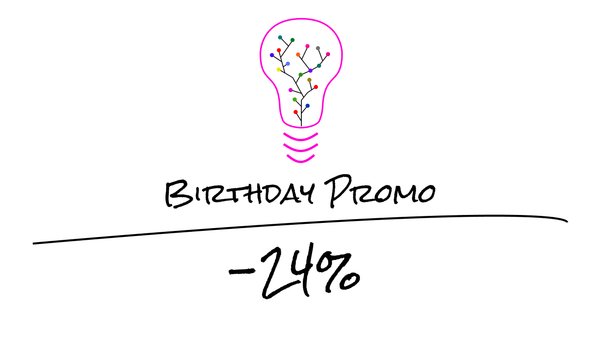How to succeed with online writing. The journey from 4K to 30K views per month. Lessons learned
How to succeed with online writing. Discover my lessons learned

Exploration! That’s what my writing “journey” is all about.
In this article, I’ll share some things that I’ve learned in recent months that helped me to have much more success with my writing.
I’ll share a part of my story, my goals, my reasons for writing on Medium, and my approach to increase the visibility of my content.
My story so far
I’ve always enjoyed writing. I remember typing entire videogame guides for my console gaming website back in 199x (I was ~14yo).
I’ve started blogging around 2005 and, for a very long time, I only published very small pieces. My posts were mostly about photography, Web development, electronics, and other geeky (ok, nerdy :p) subjects. At the time, I was mostly interested in learning everything I possibly could about software development and IT in general. It was (and still is) my one true passion.
Over the years, I’ve published my content on Blogspot, Google+, then later on my own domain using Wordpress. When I switched over to Wordpress, I set up Google Analytics and paid a bit of attention to SEO, since I was interested in getting an idea about who was ending up on my Website. Still, I didn’t give it much thought at the time. I didn’t look for popularity/visibility or anything like that. I enjoyed free and open source software and was way more interested in sharing source code than ideas.
Until last year, I never even considered trying to get revenue out of my writing skills. My journey started with a programming book deal with Packt Publishing. They contacted me through LinkedIn and proposed me to write a book about the TypeScript programming language.
That happened a bit after I had launched my IT consulting firm so for me it looked like a great opportunity to promote my skills, gain some recognition and land some consulting gigs.
After almost a year of struggle (there’s no other word for it) and 800 pages later, I did manage to finish the project. The book was published in November 2019 and a few hundred copies were sold so far (digital + paperback).
I’ve received ~1.6K € (~1.9K $) of advances in total and I don’t expect to gain any more direct revenue out of this project. Still, I consider it a valuable experience in my life. I knew I could do it and I was right. But, more importantly, it made me realize how much I really enjoyed writing.
After a small break, I started publishing articles on Medium. My initial goal was to help promote my book, but also to share my ideas and discoveries.
Over the years, I’ve worked in various domains of IT, from software development to infrastructure. I’ve worked on enterprise software frameworks, led multiple teams, managed large projects, founded my own company and experienced IT consulting for about a year (long story short: I didn’t enjoy it much). Finally, I’m now working on a SaaS startup project and am busy writing a fiction novel (with low priority).
I’m not mentioning this to brag (I hate that), but those experiences have changed me profoundly and have shaped the person I am today. I’m an avid learner and I love sharing whatever I learn about. This is true for many subjects including management, personal productivity/organization, team management, writing and also “low-level” technical details (which I’m so fond of).
The good news is that my passion is still intact and I’m not tired to learn and share new things. My current project is to build a SaaS product; it’s one of the most challenging projects I’ve embarked on, but the journey is interesting in itself. It represents a big financial bet, but it’s a risk that I’m willing to take, just to see where it will bring me in life.
Aside from that project though, I really want to keep on writing, which is why I take every opportunity to publish new articles. For now, Medium is my medium. Let me tell you why.
Why Medium?
To be honest, I’m a bit “ashamed” to say out loud that I’m trying to get revenue out of my writing. I’m ashamed because there are so many awesome people in the IT community that share their content freely, without paywalls, either on Medium or on platforms like DEV.to.
As a member of this community, I feel like a “thief”, trying to get pennies for ideas that others are sharing freely. Still, I feel the urge to try and see how far this platform can bring me.
I’m not looking for popularity or getting the big bucks. Although, I’m genuinely curious to see whether I could reach a point where my writing side-gig could pay some bills, and perhaps, give me an alternative to working half-time as an employee.
So why Medium?
Writing my book with Packt taught me that there are “chains” I’m not interested in anymore, and that getting 12% royalties for work that I’m doing 90% myself is really not worth the hassle. The financial return on investment is way too low and really not on par with the huge effort required.
My book is 800 pages long (I wrote about a thousand, but a few chapters were left out) and it took me a year to write it. Almost every day, I spent 1–3 hours working on my book. I don’t even want to count the number of hours that I’ve spent on it.
The thing is that, as a freelance software developer, I can make as much money as the book brought me in just 2–3 days of work. If you think about it, it’s completely crazy to spend hundreds of hours to end up getting just as much. Fortunately, there are other reasons. Besides, the book’s contract prevents me from reusing my content however I want to. It’s not mine anymore.
If you ever think about publishing a book, then think and act wisely. Don’t undersell yourself. If you can self-publish, then just do it. You’ll get much better returns on investment, that’s for sure!
Medium has a really interesting revenue model and does not take intellectual property rights away from me. This means that I can publish my content on Medium behind the paywall, but also republish it on my blog or elsewhere.
In addition, the publications on Medium give me access to a huge potential audience, which is not that easy to acquire on your own if you post elsewhere. I’ll explain more about this idea later in the article.
Finally, Medium articles can continue to generate revenue long after they’ve been published, which is interesting in itself.
Where I’m at right now
In the last 30 days, there were almost 32K views of my articles, which I am super proud and super grateful about.
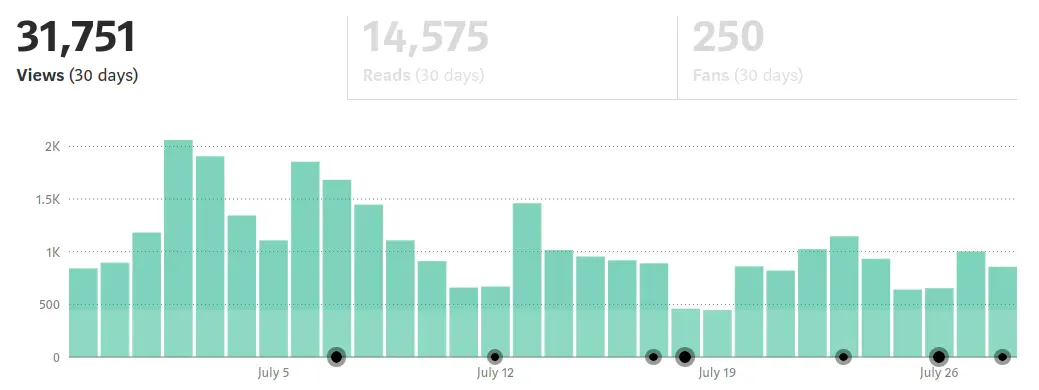
For July, I got 300$ in revenue from my Medium articles alone, up from 73$ last month. This month was particular because a single article brought me almost half of those views and ~200$ of revenue.
We’ll see what the next months are made of, but I suppose it will probably go back to 70–100$ of recurring revenue. Still, this is HUGE for me. It doesn’t pay rent, but it is quite a nice amount. I’m pretty confident that I’ll get more revenue out of Medium than out of my book.
I’ve achieved this after writing on Medium for about a year (sporadically). I’ve only started writing more articles (5–15 per month) since February of this year. Success does not come overnight. Still, there are definitely things that I’ve learned along the way that help me achieve much better results on the platform.
Those things are not secrets at all; I think that there are now hundreds of articles sharing those same ideas. But let me tell you about those anyway; just in case you don’t know already.
Follow your passion
As I’ve mentioned, IT is my main domain of expertise and my one true passion. I could write about many other subjects (and I will to some extent), but I intend to mainly focus on IT related articles.
Why? Because it’s much easier for me. Writing about something you have deep first-hand experience with is much easier and feels much more natural than forcing yourself to research and write about subjects you’re not familiar with.
While I’m 15 years into IT, I still feel like a fraud because of the impostor syndrome. Still, objectively, I do know quite a bit now and I do have knowledge and ideas to share with my peers. The same will be true for you if you follow your passion and write about it.
So if you’re starting, then try to write about what makes you tick first; it’ll be easier ;-)
Publish regularly
The single most impactful thing to do to reach better results with your writing is to publish regularly. It doesn’t mean that you should publish dull and soulless articles, but that you should put in enough effort to reach a critical mass of content. Don’t let yourself get demotivated by the low numbers at first. It’s normal.
If you’re motivated, then plan your writing; dedicate one or two sessions per week to write and publish your ideas. It’s a habit to form, just like any other.
Here are the things that I do to help me keep a steady pace:
- Wake up early to write: fresh minds think more clearly
- Collect ideas all the time: whenever I work on something interesting or learn something cool, I add cards in my Trello board, with the subjects that I could cover next; this helps me build a writing backlog
- Regularly go over my writing backlog to prioritize it, based on a few criteria: the coherence with my previous articles (e.g., continuing a series that I’ve already started), the energy that it will take me and momentum. Momentum is important because if I wait too long to write an article, then my ideas/knowledge may have faded away, which makes it harder
- Plan regular time slots for writing. Time needs to be taken; it won’t liberate itself magically. It’s way too easy to say “I don’t have time”
- Don’t burn myself out. Okay, this one is a lie, I’m a bit of a workaholic. But it’s certainly good advice for most folks out there: don’t put too much pressure on yourself. Keep a reasonable pace, but don’t make yourself hate what you do. If it feels too tiresome, then take a small break.
Vary the pleasures
Try different forms: long, short, as well as different subjects. This will serve two purposes. First of all, it’ll help you get a better sense of what feels most “comfortable” and pleasing to write. Secondly, it will let you explore different themes and reach larger audiences.
Of course, I suppose that it’s best to stick to one main area in order to create a more stable audience. But I’m just guessing, I might be wrong.. ;-)
For instance, I’m mostly writing about front-end Web development, but I also want to cover back-end development, software architecture, software development in general, and product management.
In addition to this core “IT” theme, I also want to write about other subjects such as team/people management, project management, leadership, entrepreneurship, productivity, personal development, writing, photography, etc. But these will probably remain secondary subjects. I feel comfortable writing about all of those, but they’re not my passion per se.
Be efficient
Pay attention to the time you spend writing your articles. I sometimes spend an entire evening for a single article. Sometimes it’s normal, but most often it’s not and it just means that I’m fooling around or that I’m wasting time rephrasing things endlessly (I’m really good at that!).
Take my advice and use the Pomodoro technique to try to time box your writing. Use 25-minute sessions and see how much you can write.
- 0–5 minutes: list your ideas using bullet points, then find the correct order and try to structure those
- 5–15 minutes: once you have the base skeleton, you just need to fill in the blanks
- Finally, read your article out loud and adapt what you don’t like
If one session is not enough, then do a second pass. But do keep using the timer. Otherwise, you’ll waste time as I do. It’s fun and I do enjoy playing with words. But sometimes it’s detrimental to the quality of my work.
Observe the past to predict the future
One of the habits that help me improve over time is to review and evaluate the success of my past articles.
In Medium, you can go to the stats page to get an idea about how successful your articles are:
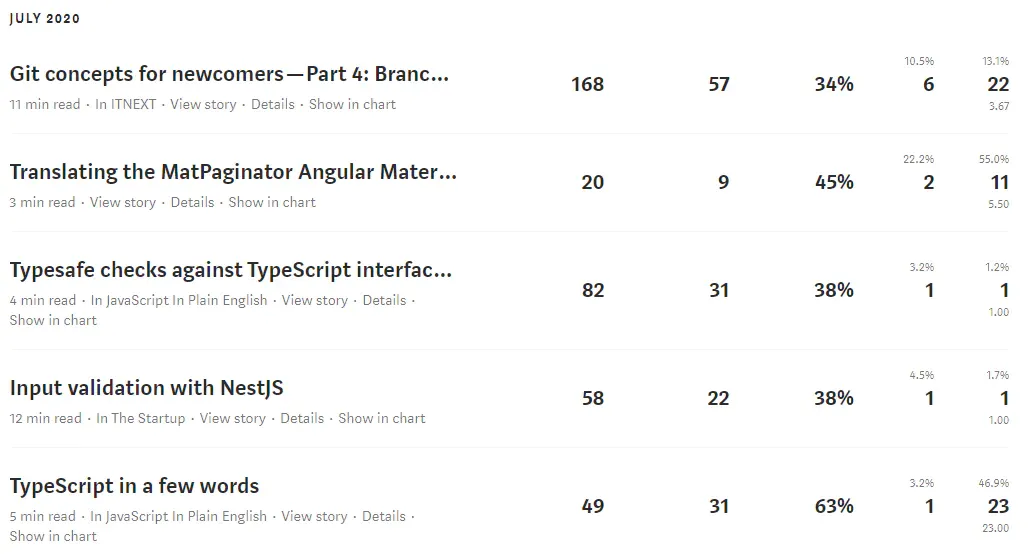
Note that the default stats view does not look like this. I’m using the awesome Medium Enhanced Stats Google Chrome extension created by Tomas Trajan, which adds more information like the number of claps, better charts, etc.
So what can we learn from these stats?
First of all, I can see that my article about input validation with NestJS doesn’t have much success. Only ~60 views, but more importantly only 38% read ratio and a single “clap”; meaning that there’s not much interest in the content. This could be due to multiple things:
- Maybe I didn’t reach the target audience (maybe the people who follow me are more interested in front-end software development). To verify that, I should share it around a few times, maybe trying different hashtags on social networks
- Maybe the title of the article is not clear enough: I could change it to see if there’s an impact
- Maybe the article is too long or too broad
- etc
In reality, there are probably different things at play and it’s not always easy to guess. Still, it’s important to try and understand what’s wrong and what could be improved.
In practice, the impact on revenue is dramatic. The article about NestJS got me 0.11$ while the article about Typesafe checks got me 0.68$ with only 20 more views.
One important lesson is that the view/read ratio has a really big impact on revenue, which is intuitive since it correlates with interest.
Now let’s look at my most recent successful articles:
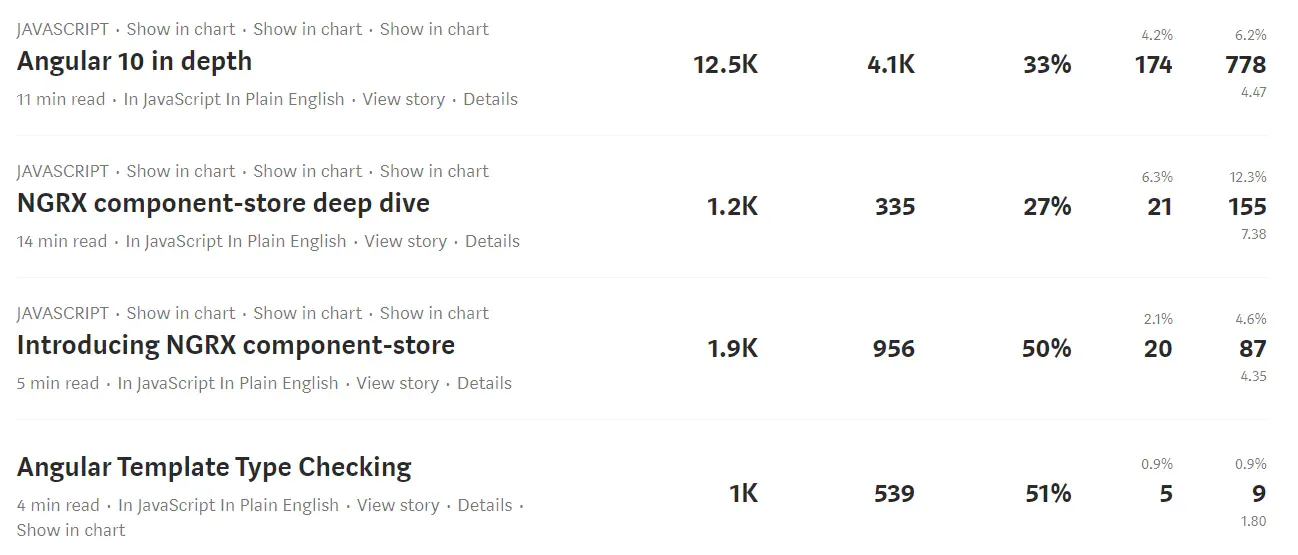
As you can see, the read ratio of the “Angular 10 in depth” article is quite low, but the number of views and claps is much much higher. This means that this article came at the right time, had an appealing title, and had interesting content overall. People clearly wanted to read this.
The next two articles also have more than 1K views (which is not bad at all), and many claps. So these touch a smaller audience, but there’s a clear interest for that content.
Finally, “Angular template type checking” article also got quite a lot of views and people paid more attention to the content.
Based on these stats, I can clearly see that there’s interest in news articles. I’m pretty convinced that I’ll get increased views if I write more about what’s new and shiny in the software development world. And it’s no wonder. Everyone (myself included) is interested in what’s coming next.
Also, I can see that my attempt at doing a real “deep dive” article was relevant, but may not be worth the effort. I’ve spent many hours preparing that one, but people actually don’t read it in detail. So yes it’s interesting, but there are better options for me to have more success.
Reviewing the results of previous articles is super useful to understand the expectations of your audience. Doing this regularly guides me to write better articles and avoid subjects that don’t seem to interest my audience. In addition. By doing this and trying out different things (e.g., different subjects, different styles, different titles, etc), you can see if there’s a positive impact.
Another thing to do, independently of the stats is to look at the revenue generated by your articles. Once you start getting some money out of your writing, you can simply look at how much each article generates and compare that to the time/effort it took to write it to evaluate if it was worth it or not.
Use the right hashtags
Tags are super important to raise the visibility of your articles. Over time, I’ve started paying attention to the tags and generally prefer adding the relevant ones that have the most subscribers.
For instance, I prefer using “Programming” (135K) vs “Coding” (49K). Each nice has its own “star” tags. Do your homework and find which ones those are.
Tags help people interested in specific subjects to find articles that match their interests. So the more precise you can be, the more reach you can achieve.
If you look at the stats of specific articles, then you can see the interests of your readers. Do take a look at those to help you choose better tags:
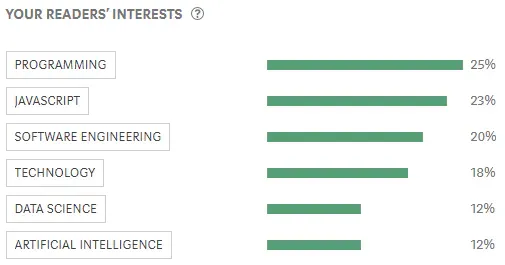
Join (popular) publications and get curated
This is well-known advice on Medium, but one that made a huge difference for me.
In the beginning, I didn’t understand why or how to join publications, so I just published my articles and tried to promote them on my own. It did work but was not very effective.
Since then, I’ve joined a few Medium publications (e.g., The Startup, ITNext, JavaScript in Plain English, Management Matters, etc) and publish all of my articles through those.
Publications help me reach a much larger audience. For instance, JavaScript in Plain English has ~30K subscribers, and “The Startup” has 635K (phew).
Without a doubt, getting my articles accepted into publications has had a huge impact on the success of my writing activity.
Adding my articles to a publication doesn’t mean I’m losing the IP rights; I fully preserve those and can withdraw my articles whenever I want to. Also, I keep the revenue in full (afaik), so there’s really no reason to miss out.
Also, editors of some publications can also curate articles for specific sections of Medium (e.g., JavaScript) and get your articles on more screens.
I’ve had the chance to get a few of my articles curated and the impact was important.
Pick good titles
The title of your article is the very first thing that readers will see.
There are countless guides about this, but it does matter a lot. If you fail to chose a good title, then people will keep on scrolling and they won’t even open your article.
Think about SEO
Whenever I publish an article, I make sure to edit the settings in order to write a good description:
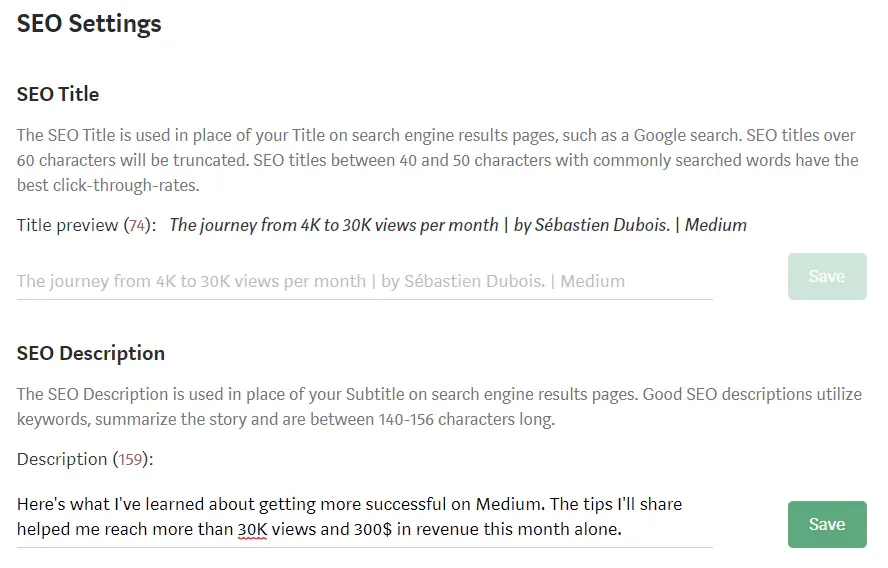
I’m convinced that these settings are of critical importance for better appearance in search results (on Medium, but more importantly on Google and other search engines).
By default, the SEO title is the title of the article (usually good enough for me), but the description is just taken from the first sentences of the article; usually, the description needs to be adapted.
If you look at the stats of an article, you can see a breakdown of the views by traffic source:
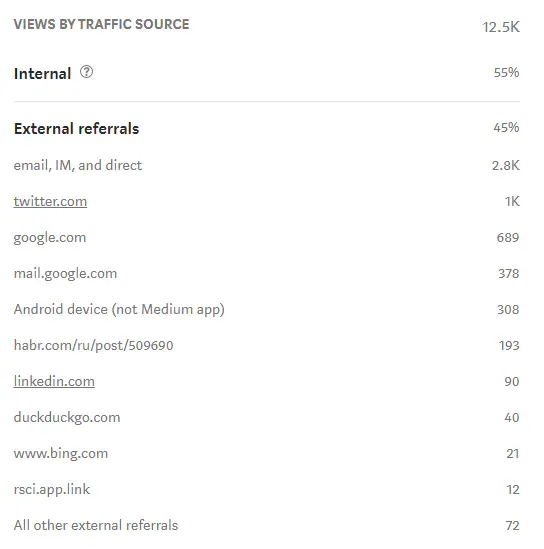
This is useful as it shows where your audience is coming from. Based on that, you can try and see how to increase the numbers from these different sources.
Use a stable article structure
In my articles, I usually keep the same structure, which I think is appreciated by my audience:
- A first sentence to give an idea about what the article is about
- A picture, usually taken from Unplash, corresponding (more or less) to the subject
- A small paragraph or two about what I’ll cover in the article
- An introduction on the subject
- The core subject matter
- A conclusion where I do a recap of what I’ve covered in the article
- Links to my profile, mailing list, etc
This structure is really basic, but I think that it’s good enough. It helps me structure my writing and be more productive. In addition, it helps readers find their marks; if they’re used to me articles, then they gain time.
Note that the picture is really a must. It adds a “face” to the article. Without that, your articles will only appear as blobs of text and will be far less appealing to potential readers.
Cross-reference articles
If you cover subject X and touch a bit on subject Y, then it’s a great opportunity to link back to previous articles that you wrote on Y.
Over time, as you add content to your blog, you’ll get more and more opportunities to cross-reference your posts. Don’t miss those opportunities, as they provide a great way to let your readers find more articles they might be interested in.
The web is made of links and people love exploring! ;-)
Promoting your content
I don’t know that many people that like doing self-promotion, but it’s actually inevitable. Without promoting your content, you will probably never be successful.
Digital marketing is not that hard to learn about. Of course, there’s a gap between promoting your articles and being a full-time digital marketer. Marketing articles is rather easy, so don’t be afraid ;-)
Here’s what I currently do.
Right after publishing an article and adding it to a publication, I write a small Tweet telling about my latest article and trying to condense the subject in a one-liner. I’m usually quite verbose so it is HARD for me to keep things short, but it’s a must (otherwise people don’t read).
After that one-liner, I add the link to the article and I finish up with a few carefully chosen hashtags. I’ve read that hashtags can feel spammy, and I can understand that, but I feel like they do help me reach a larger audience.
Recently, I’ve been using hashtags like #100daysofcode, because I’d really love to reach more junior software developers. I want to share the things that I’ve learned over the years and have had a blast with mentoring and coaching. If I could do the same online, I’d be thrilled.
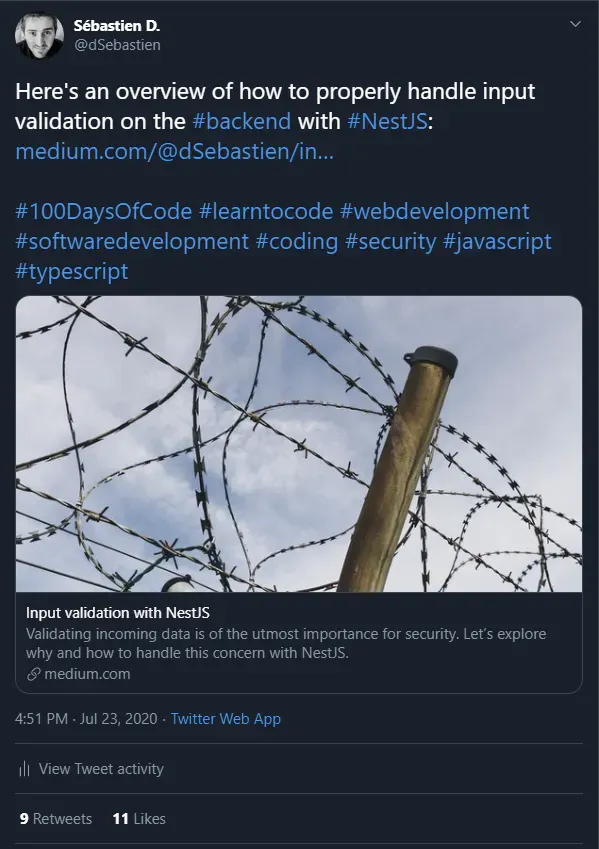
Once the tweet is sent, I usually re-share it with my company’s Twitter account.
After that, I also post the very same message on other social platforms like LinkedIn and Facebook and also re-share with my personal/company’s account.
I’m sure there are avenues for improvement here for marketing my content, but that’s what I currently do.
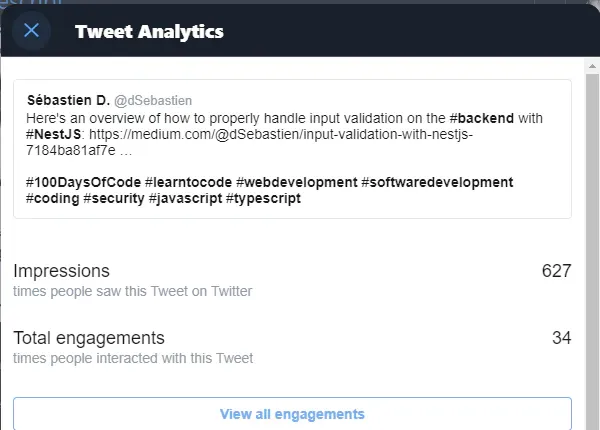
By looking at the analytics, I can also get an idea about how many people have interacted with the tweet.
Another dimension of the promotion work is the fact that you can use your articles and social media platforms as channels to raise awareness about your products and services.
Many authors that share their content freely are actually feeding their consulting business, which is (at least partly) why they don’t want to sit behind paywalls.
Socialize
This might sound stupid, but as an introvert, socializing is not that easy. Still, it’s really important to gain visibility with your content.
For many years I’ve been following people that I find interesting on Twitter. I now follow 5K people (and Twitter won’t let me follow more ^_^). Of course I can’t read it all, but I like seeing interesting content appear on my “wall” all of the time. On LinkedIn, I’ve also accumulated many contacts through work.
All of those people are somewhat “reachable” for me. When I share content, there’s a chance that they’ll see it appear and might interact with it.
In addition, I have a genuine interest in what the members of my community are doing/sharing and I often like/re-share/comment on their content. I don’t do that hoping to get something in return, but people indeed to appreciate it and sometimes do the same for me. For instance, Santosh Yadav (who is an awesome human being by the way), has re-shared quite a few of my articles and has helped me reach many additional readers.
It’s just how we humans work; we usually like to give back to those who have helped/supported us in the past.
In conclusion, followers matter a lot, on Medium as well as on other social networks.
Share more than once
A few weeks back, I’ve started to realize that there’s no reason to promote my articles only once. I never gave it much thought, but so far I was simply writing, publishing and promoting my articles a single time.
Now, I’ve started sharing my articles a few more times. The thing is that given my small reach on Twitter (~700 subscribers) and LinkedIn, I have quite little chance to get a lot of visibility in one shot, depending on when I post my message, when people see/read it, etc.
By posting about my articles multiple times (different days, different hours), I rise the chances of getting my content in front of more readers. Of course, there’s a reasonable limit; I can’t start spamming the same articles over and over. But still, it’s worth trying a few times here and there.
Cross-post
As I said earlier, Medium doesn’t take your intellectual property away. So, unless the publications that you’re sending your articles to say otherwise, then you keep the right to publish your content elsewhere.
For instance, I sometimes cross-post my articles on DEV.to, which is appreciated by readers who don’t like paywalls. When doing so, I mention the fact that my article first appeared on Medium (or at least point to the fact that I’m mainly writing on Medium). That way, I can get new readers to discover my content.
This might seem futile, but the more visibility you create, the more success you can achieve. Of course, more reads not only means more revenue, but more people that get a chance to learn a thing or two from you. I don’t know about you, but I do value that a lot.
Create series and derived works
Something that I’ve tried recently is to create a series of articles.
Out of curiosity, I’ve decided to explain Git concepts for beginners. I’ve just published part 4 and I’ll probably write 10–12 articles in total. Writing this series is rather easy for me since I’ve been using Git professionally for many years. So the time/effort to create the series remains reasonable.
Each article in the series points to the previous/following ones. If someone reads one of the articles then there’s a good chance that they’ll keep on reading (assuming the content is pleasing to read and if the quality is high enough). That alone is a good enough rationale to invest in writing series.
In addition, I consider creating this series as a first step towards creating a full-blown course about Git. This could take different forms: a video course, an e-book, etc.
Indeed, there are tons of courses about Git out there already. But I won’t let that stop me; it doesn’t mean that I cannot have success with mine.
Creating derived work is certainly a great way to become more successful and generate additional revenue. But of course, it requires work and dedication.
Create a relationship with your audience
This is something that I’m still a newbie at, but I’m now trying to get “closer” to my audience. A few months back, I’ve started publishing a newsletter about software development.
Through this newsletter, I have one more channel to reach the people who are interested in what I have to share and I can write more “personally” (I see it as a sort of “backstage” for my writing activity).
Many authors are wildly successful with their newsletters (reaching hundreds) and manage to create additional revenue, for instance through ads, affiliate systems, and subscriptions.
I believe that there are many options, but I can’t comment much for now. So far, I “only” have 25 subscribers, but I intend to continue investing time in reaching more people.
I’ve published ten newsletters so far, and intend to make it a thousand! ;-)
Newsletters are also great to mention articles that your readers might have missed and thus increase the chances of getting additional views.
Finally, note that it’s really easy to create one using services like Mailchimp.
Look for sponsors
One last thing I want to mention is sponsor programs.
I’m just getting started with this, so I don’t have any sponsors yet, but I think that this is also something to take a look at if you want to have more success and generate more revenue out of your writing.
If you find your audience and people enjoy the content that you create/share, then you can try and get them to sponsor your work.
In my case, I’d be thrilled is someone sponsored me. It hasn’t happened yet, but it might have to do with the fact that I haven’t pushed anyone to do so already.
Creating a page on Github sponsors or on platforms like Patreon is crazy simple and could help you out.
So what’s in for your readers? Well, it’s up to your imagination. For instance, you could let your sponsors prioritize your writing backlog, or write sponsors-only articles, etc. There are countless ways to make this relevant.
This is definitely something that I’d like to explore in the coming months. I’d love to get sponsored to help the IT community, whether through writing, software development, coaching, or mentoring!
Conclusion
In this article, I’ve shared a bit of my story with you. It’s not the whole story (I don’t want to bore you too much), but it’s enough to give you an idea about why I’m writing and where I’m coming from.
I’ve also shared a few tips and tricks about how to have more success with your writing. It might not be much, but those things surely did help me a lot.
I’m not able to live from this activity alone, but my recent “success” (everything is relative) has felt great! Each buck that I gain on Medium feels a whole lot better than the hundreds I get each day when doing consulting work.
I guess that I fancy the idea of making a living from writing full-time. We’ll see how things evolve ;-)
That's it for today! ✨
About Sébastien
I'm Sébastien Dubois, and I'm on a mission to help knowledge workers escape information overload. After 20+ years in IT and seeing too many brilliant minds drowning in digital chaos, I've decided to help people build systems that actually work. Through the Knowii Community, my courses, products & services and my Website, I share practical and battle-tested systems. You can follow me on X 🐦 and on BlueSky 🦋.
I am an author, founder, and coach. I write books and articles about Knowledge Work, Personal Knowledge Management, Note-taking, Lifelong Learning, Personal Organization, and Zen Productivity. I also craft lovely digital products.
If you want to follow my work, then become a member and join our community.
Ready to get to the next level?
If you're tired of information overwhelm and ready to build a reliable knowledge system:
- 🎯 Join Knowii and get access to my complete knowledge transformation system
- 📚 Take the Course and Master Knowledge Management
- 🚀 Start with a Rock-solid System: the Obsidian Starter Kit
- 🦉 Get Personal Coaching: Work with me 1-on-1
- 🛒 Check out my other products and services. These will give you a rock-solid starting point for your note-taking and Knowledge Management efforts



